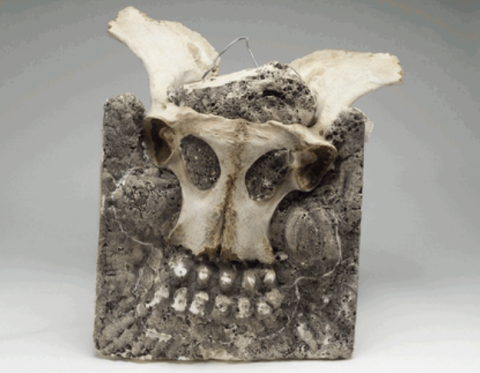Fetish for the Hunt
Stone sculpture made with the hip bone of a cow.
Dennis Christy Sr has been an artist all his life. His grandmother was a basket maker and she taught him how to carve wood. Christy attended the Institute of American Indian Arts in Santa Fe, New Mexico and graduated with a Fine arts degree in 1975. As a student, he made jewelry, pottery, and paintings. When asked how he became interested in sculpting he chuckled and said "I had a case that I kept all my jewelry in. One day, someone broke into my car and stole it. Stone sculptures are a lot more difficult to steal than jewelry!" He noticed similarities between wood carving and stone carving as he watched other students.
Fetish for the Hunt was sculptued for a single class project. Christy's instructor Seymour Tubis took the students to the back of the building where there was a pile of scrap material and told them to create something. Christy selected the cow hip bone and filled it with sand cast, making the "teeth" of the sculpture with his fingers. The project took roughly 20 minutes and later on Tubis approached Christy requesting to buy it. It was purchased by the Indian Arts and Crafts Board who later donated it to the Smithsonian. The name of the sculpture was inspired by the Pueblo peoples of New Mexico who often titled their pieces with the name "Fetish" so Christy did the same.
When asked what he wanted people to know about his artwork, Christy said, "I'm a part of Smithsonian history! Not everyone has that claim to fame. Years from now this will show people who we are. Our artwork leaves a footprint of our culture."
As well as having pieces at the Smithson, Christy has pieces at the Ford museum in Grand Rapids, Michigan as well as the Soaring Eagle Casino and Andahwod Senior Care in Mt. Pleasant. His studio, Thunderhammer is still in operation though Christy is semi retired.
Purchased by Indian Arts and Crafts Board representatives from Seymour Tubis (Chairman and Instructor at the Institute of American Indian Arts, Santa Fe, New Mexico, from 1963 to 1980) in 1981; part of the IACB Headquarters collection (Department of the Interior, Washington, DC) until 2000 when it was transferred to NMAI.

